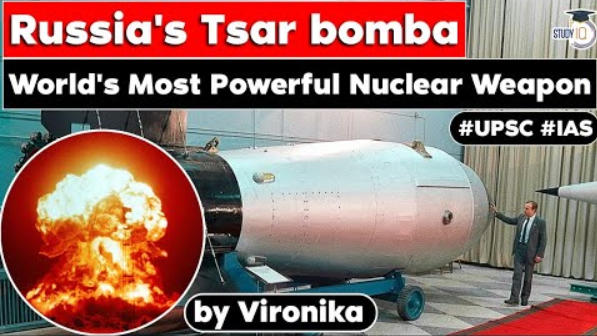Table of Contents
Russia’s Tsar bomba
- World’s most powerful nuclear weapon of mass destruction
- On February 27, 2022, Vladimir Putin ordered that the Russian nuclear forces be put on high alert after launching military attacks against neighbouring country Ukraine.
- Meanwhile, this week the Ukrainian ambassador in Washington claimed that Russia used prohibited weapons such as vacuum or thermobaric bombs.
- “Senior officials of leading NATO countries make aggressive statements against our country,” said Putin.
- “Therefore, I order the Minister of Defence and the chief of the General Staff to place the containment forces of the Russian Army in a special mode of combat duty.”
How many nuclear weapons does Russia have?
- Currently, the only nine countries who have nuclear weapons are China, France, India, Israel, North Korea, Pakistan, Russia, the United States and the United Kingdom.
- The Federation of American Scientists reports that Russia possesses 5,977 nuclear warheads, which could be considered strategic nuclear weapons.

Tsar Bomba
- The country’s most powerful nuclear weapon was produced in during the Soviet era called the Tsar Bomba.
- It is believed the bomb was the most powerful weapon of mass destruction which was developed in 1961 during the Cold War.
- Tsar Bomba was over 25 feet long and weighed almost 30 metric tons. It was similar in shape to the ‘Little Boy’ and ‘Fat Man’ bombs that the United States had used to devastate Hiroshima and Nagasaki fifteen years prior, but that was as far as the similarities went.
- It was too big to fit inside even the largest of Soviet aircraft and would need to be specially mounted to one to be taken to its drop site.
- The Tsar Bomba is a hydrogen fusion bomb. Hydrogen bombs are generating power by using of a combination of nuclear fusion and fission processes, which makes the explosion much more powerful.
- The Tsar Bomba is the most powerful energy device ever used.
- The bomb when it was tested in Novaya Zemlya Island in the Arctic Ocean was reportedly visible from 1,000 kms away. Reports claim the explosion rose to a height of 67 km.
- It was the most powerful human-made explosion ever recorded, according to reports. It was 3,800 times the strength of the US nuclear bomb dropped on Hiroshima and Nagasaki in August 1945. The bomb was also known as RDS-220.

Tsar Cannon
- The Tsar bomba exploded about 4 km above the ground and reportedly produced a mushroom cloud 60 km high.
- The bomb destroyed an uninhabited village 55 km from Ground Zero with damage to buildings seen from 100 kms away.
- Reports say a seismic shock wave which was equivalent to 5.0 on the Richter Scale was measured around the world.
- However, the bomb was never put to operational use and wasn’t developed as a ballistic missile. It was widely seen as a “propaganda” weapon at the height of the Cold War.
- The “Tsar Cannon” was tested in the same year as the Cuban missile crisis in 1961.
How does a hydrogen bomb work?
- A hydrogen bomb is a type of nuclear bomb, just like an atomic bomb, where the explosive energy comes from as nuclear reaction. The difference comes from how that energy is created.
- An atomic bomb uses fission, that is, the breaking of an atom’s nucleus into smaller particles. This results in the release of neutrons and lots of energy that become an atomic explosion.
- In comparison, a hydrogen bomb is about fusion — fusing atomic nuclei together to combine into bigger ones.
- A hydrogen bomb, or a thermonuclear bomb, contains a fission weapon within it but there is a two-stage reaction process.
- It uses the energy from a primary nuclear fission to set off a subsequent fusion reaction. The energy released by fusion is three to four times greater than the energy released by fission, giving the “hydrogen” bomb, or H-bomb, more power.
- The name comes from the fact that it uses a fusion of tritium and deuterium, hydrogen isotopes.
Russia’s Naval Strategic Nuclear Force
- The submarines are expected to form the basis of Russia’s naval strategic nuclear force.
- The Knyaz Vladimir submarine is the first upgraded 955A model to be produced in the Borei class of Russian nuclear-powered ballistic missile submarines.

Question:
Which of the following atomic particle have a least mass?
- Proton
- Electron
- Deuteron
- Neutron


























 WhatsApp
WhatsApp